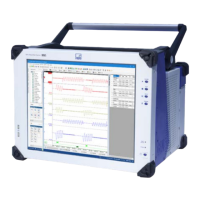GEN7iB
282
GEN series SYNCHRONIZATION METHODS
GEN series SYNCHRONIZATION METHODS
14
14.2 PTP
14.2.1 PTP
(1)
technology background
(1)
Source: Wikipedia
®
the free encyclopedia
The Precision Time Protocol (PTP) is a protocol used to synchronize clocks throughout
a computer network. On a local area network, it achieves clock accuracy in the sub-mi-
crosecond range, making it suitable for measurement and control systems.
PTPwasoriginallydenedintheIEEE 1588-2002standard,ociallyentitled“Standard
for a Precision Clock Synchronization Protocol for Networked Measurement and Control
Systems” and published in 2002. In 2008, a revised standard, IEEE 1588-2008 was
released. This new version, also known as PTP Version 2, improves accuracy, precision
and robustness but is not backwards compatible with the original 2002 version.
Architecture
The IEEE 1588 standards describe a hierarchical master-slave architecture for clock
distribution. Under this architecture, a time distribution system consists of one or
more types of communication media (network segments) and one or more clocks. An
ordinary clock is a device with a single network connection and is either the source
(master) of or destination (slave) for a synchronization reference. A boundary clock
has multiple network connections and can accurately bridge synchronization from
one network segment to another. A synchronization master is selected for each of the
network segments in the system. The root timing reference is called the grandmaster.
The grandmaster transmits synchronization information to the clocks residing on its
network segment.
The boundary clocks with a presence on that segment then relay accurate time to the
other segments to which they are also connected.
AsimpliedPTPsystemfrequentlyconsistsofordinaryclocksconnectedtoasingle
network. No boundary clocks are used. A grandmaster is elected and all other clocks
synchronize directly to it. IEEE 1588-2008 introduces a clock associated with net-
workequipmentusedtoconveyPTPmessages.ThetransparentclockmodiesPTP
messages as they pass through the device. Timestamps in the messages are corrected
for time spent traversing the network equipment. This scheme improves distribution
accuracy by compensating for delivery variability across the network.

